Who doesn’t love pesto, right? It’s rich, flavorful, and it can turn something completely boring (like pasta) into something spectacular. The only problem is that it’s full of expensive ingredients (fresh herbs, pine nuts, olive oil, cheese, etc.). So, I’ve made this simplified “beggar’s pesto” to satisfy my cravings for pesto pasta.
I can usually get parsley for less than a dollar per bunch so I substituted it for the usual basil. Parsley still lends a bright, fresh flavor, which is needed to balance the rich olive oil and zesty garlic. I skipped the pine nuts all together, but you can also try using about a half cup of walnuts if you’ve got a few dollars to spare. Try to buy the walnuts from bulk bins so that you only have to buy the small amount that you need. I actually forgot to buy a fresh lemon, so I used some lemon juice that I had in my fridge. You can use the juice from one whole lemon and also add in the zest for more flavor.
This recipe for Parsley Pesto Pasta is really quick and easy, and makes a ton. It makes 8 side dish sized servings (2 oz. pasta each), or 4-6 main dish servings. Add some grilled chicken and a fresh side salad for a complete meal! Also, check the bottom of the post for a few variation ideas.
Parsley Pesto Pasta
Parsley Pesto Pasta
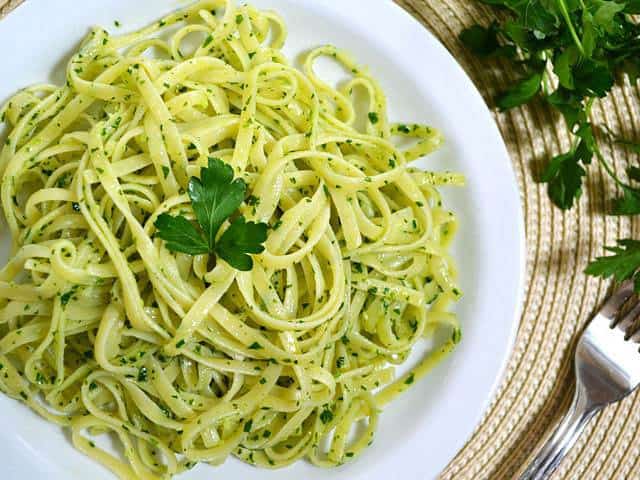
Ingredients
- 1 lb. fettuccini ($1.29)
- 1 bunch Italian parsley ($0.85)
- 1/2 cup grated parmesan ($0.48)
- 2 Tbsp lemon juice ($0.12)
- 2 cloves garlic ($0.16)
- 1/4 tsp salt ($0.02)
- 1/2 cup olive oil ($1.26)
Instructions
- Rinse the parsley well and shake off as much water as possible. Remove the leaves from the stems and place them into the food processor. Also add the garlic (peeled), parmesan cheese, and lemon juice. Pulse until there are no large chunks of garlic left.
- Slowly add the olive oil through the spout on the lid as you continue to pulse the mixture. Scrape down the sides of the bowl as needed and pulse until smooth. Taste the pesto and add salt to your liking. I added 1/4 teaspoon. You want the pesto to be slightly saltier than you’d think because it will be spread out thin over the pasta.
- Cook the pasta according to the package directions (this can done while you make the pesto). Before draining the pasta, reserve about a half cup of the starchy cooking water. Drain the pasta, let cool slighly (about 5 minutes) and then return it to the pot. Add the pesto and stir to coat. If the pasta becomes dry, clumpy, or sticky, use a small amount of the pasta water to help loosen it up. Serve warm!
See how we calculate recipe costs here.
Nutrition
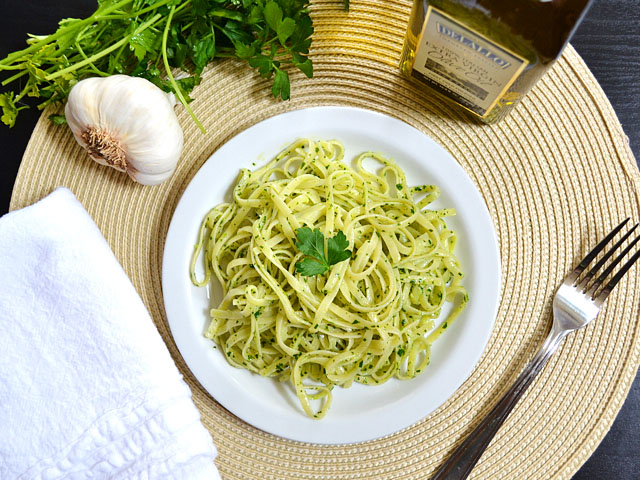
This post contains some affiliate links, which means that we make a small commission off items you purchase at no additional cost to you.
Step By Step Photos
This is pretty much all you need (plus olive oil) to make this simplified pesto. Parsley, lemon juice, garlic, parmesan cheese, and olive oil. Make sure your parmesan is 100% parmesan and not grated parmesan mixed with fillers.
Rinse the parsley well and shake as much water off as possible. Pick the leaves from the stems and place them in the bowl of the food processor. To easily remove the leaves, just pinch and the base of each cluster of leaves and pull out toward the end. The leaves (and maybe a little stem) will come right off. Place the parsley leaves, peeled garlic, parmesan cheese, and lemon juice in the food processor.
Pulse the ingredients until there are no large chunks of garlic left. It doesn’t have to be super fine because you’ll pulse more as you add the olive oil.
Slowly add the olive oil through the spout as you continue to pulse.
Once the mixture is smooth, give it a taste and add salt as needed. The parmesan is fairly salty on it’s own, but I still added 1/4 tsp of salt because I knew the flavor would be diluted slightly when it was spread out over the pasta.
Cook the pata according to the package directions. Before draining it, reserve a little bit of the starchy pasta water. Drain the pasta, let it cool for a few minutes, and then return it to the pot. Pour the pesto over top.
Stir the pasta and pesto to coat. If the pesto pasta has become dry, sticky, or clumpy, add just a little of the reserved pasta water to help loosen it up. The starchy pasta water is preferred because the starch will actually help the pesto stick, as opposed to making it slip right off like plain water.
Serve the parsley pesto pasta warm!
Other variations to try: add black pepper, lemon zest, other fresh herbs, walnuts, cayenne pepper… the possibilities are endless!


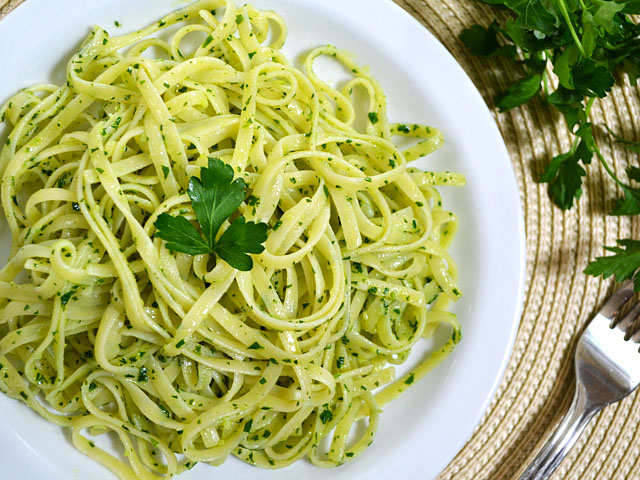
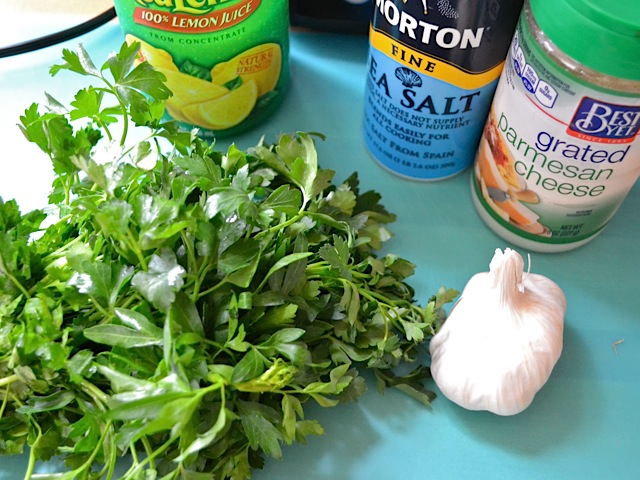





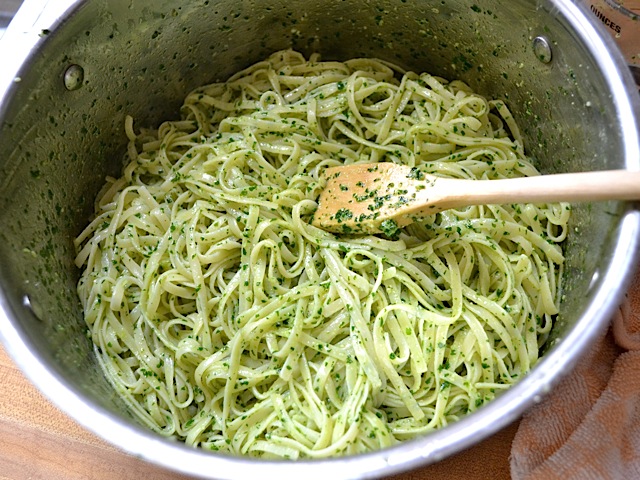

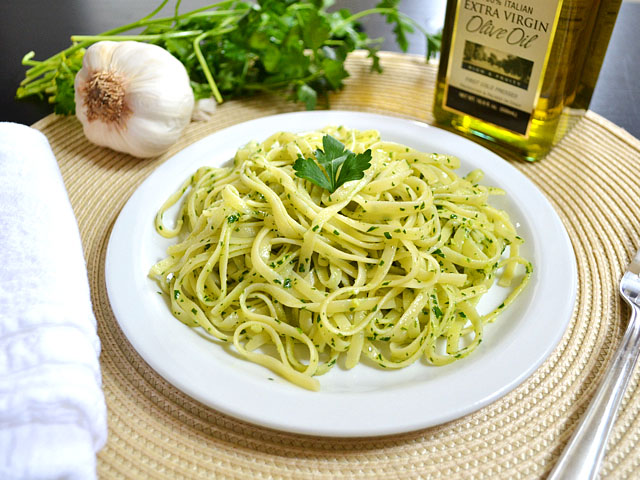
Fresh, easy, and cheap. I was worried because I only have a very small food processor attachment for my immersion blender. But it worked out just fine and was able to fit all the ingredients! A very satisfying meal.
Delicious! I added lots of walnuts to the mix, as you suggested in the intro, and even added crushed walnuts as garnish. It worked well with Farfalle pasta.
Very good and easy, I will be making this again.
great recipe
INCREDIBLE
Nnnoooiiiiccceeee guys I did it too
Wait you did this recipe too anirolF?!?
This recipe was great for my school assignment, I love how easy it is to make it and it tastes incredible!!
Loved it!! It felt fancy for being so cheap
there is no directions the instuctions are too longgggggi dontwanna coy qnd pasre t noooooodmesdojvnsdkmd fn ioks bad website no no i have to o this for shool and u dont wanna help me do it easir kewnfwi
My mother used to make green spaghetti, a favorite. Spaghetti cooked, a little oil, and lots of dried parsley, and Parmesan Cheese (she always used Kraft). Dried parsley turns it green, and delicious, and cheaper even than fresh.
Delicious! I’ve made it exactly to recipe and it’s great, but I’ve also experimented and want to note that it can be made vegan by subbing nutritional yeast (look in the bulk section at health food stores if you don’t want to spring for a whole tub) for Parmesan and adding a touch more salt. I also added the zest of half a lemon.
Me too, I added the zest of the lemon I squeezed, and even some lime juice.
I will be trying it with some nutritional yeast (which I bought by mistake, thinking I could make seitan with it, but it’s not gluten flour…).
I use sunflower seeds- a cheaper alternative that still packs a crunch!
Hello! I have lots of dried parsley, could I sub for dried? Thank you!
You can- but it is different ratios, and the texture will be different. Since we haven’t made it with dry, we can’t give you any guidance. My best advice is to taste as you prep the sauce and go with your gut and your palate. XOXO -Monti
I hate to tell you this, but that bottled junk is not at all cheese!
It depends on the brand. Some brands are, some aren’t. You just have to check the label.
Agreed. If it comes in a shaker canister, like Kraft Krap, it’s not worth using. Buy the real stuff in the refrigerated cheese section at a grocery store.
Another excellent recipe. Very fresh-tasting.
Question
Can parsley pesto be frozen and used at an other time?
Thanks
I haven’t tried it, but I know many people freeze other types of pesto, so I would guess that it would work.
This is super! You can also add some walnuts while grinding it to make it much more creamy!
This was delicious and so very easy!! I used home grown parsley and the zest from the lemon that I juiced. Waste not, want not! Wish I could give more than 5 stars!
I wanted to ask how many almonds should be needed if you’re making it with almonds and also should I roast them?
Hey Jess,
I added a 1/2 cup of walnuts to the recipe, and the recipe tastes great. I didn’t alter any other ingredients. I think roasting the nuts beforehand would add a great flavor, but I didn’t to save time and it still turned out tasty!
~ Andrea
For an even more satisfying, protein-packed lunch to take on the go, I add a sprinkling of chopped pecans and turkey bacon crumbles to this dish! It’s already good, but that makes it great.
Hey Beth,
Just wanted to say when I make this recipe I always use the stems of the parsley. It never affects the texture for me. This also works great with the woody ends of asparagus that you snap off. Carrot greens and kale stems work great as well (though I usually mix those with parsley for some added flavor). Pesto is just an easy way to use up those normally discarded bits of greens.
Good to know! Thanks! :D
Forgot to rate
I’ve just made some parsley pesto to liven up some potato and onion soup ( made with stock from the carcus of Sunday’s roast chicken) adding 1 tsp to each bowl. There’s loads of pesto left so I’m going to grind up some walnuts and have it with pasta tomorrow. Great recipe ideas, thanks.
Oops, forgot to rate. Don’t want it to miss out on those five stars!
Made this to pair with the honey balsamic chicken tenders and it was a perfect match – very light and flavorful, but not overpowering. I used dried parsley because it was all I had, but it still tasted great! I really like this simple recipe for pesto because it’s cheaper and I usually can’t buy pre-made pestos because they have cheese (lactose-intolerance sucks!). This was a great alternative and I have leftovers for tomorrow… or later tonight when I want a snack. ;)
Can I just say i LOVE your blog! I too wish I had a food processor but as soon as I can convince one of my friends to lend me one I am trying this :) Thanks!
use a blender
I wish I had a food processor :(
This was so good! I didn’t expect it to pack much of a punch, but it did! Had it on spaghetti squash, perfect summer dinner. Didn’t even have to turn on my stove.
I love parsley pesto! it is so refreshing! but i haven’t try it on pasta! I will – this week.
Monika
Toasted sunflower seeds are a good substitute for pine nuts or walnuts and MUCH cheaper :) They’re also a good alternative for those of us that are allergic to tree nuts. I don’t like regular pesto as I’m not fond of high concentrations of basil, but a parsley or mixed herb and sunflower seed pesto is yummy :) And definitely grow your own parsley if you can manage it – mine usually grows huge enough that I have plenty to dry at the end of the season and use all winter long.
Love how this post shows that eating fresh herbs isn’t out of the question when trying to eat on a modest budget! Thank you for sharing this fantastic pesto/pasta recipe!
Yum! I posted about Arugua Pesto today, I guess we’re all craving lighter spring dishes. That plate of pasta looks divine.
Amy – I served it along side some grilled chicken breast. But, if you want to add the protein right in, a drained and rinsed can of white beans might be good! And then maybe a few grape tomatoes cut in half for some color? Mmmm! I’ve been adding an extra sprinkle of parmesan too ;)
*Hey commenter Lisa! I’m waving at you from Franklin, TN! :)
I wonder, if you wanted to leave out nuts because they’re expensive/you have allergies, could you substitute chickpeas? If you add in a few chickpeas after pulsing the rest of the ingredients together and then pulse a little bit more, it would give it a bit of a chunky consistency like the nuts instead of the consistency of hummus, right? Or possibly roast the chickpeas first to make them crunchy? I dunno, I’ve never tried this, so I could be way off.
Glad I took another look at this post. I saw Pesto…and usually it’s not made with Parsley so I don’t like it.
However, this could become my new favorite!
Any suggestion on how to get some protein in this dish?
Pesto is love. :) I often substitute walnuts for pine nuts and combine parsley an d basil to reduce the costs of the dish.
Last year, however, I decided to grow my own basil ($1.99 for a package of seeds), scrounged up some plastic pots from the attic, bought a bag of potting soil and went to work. I realize that’s not at option for everyone but if you do have room for some containers and a sunny place in your home or a garden, it can really help. Or, you can share a friend’s garden and split the resulting basil. Periodically harvest all the plants, dig them up (compost the roots etc) and plant new young seedlings so you can have fresh pesto all summer long.
And, once you’ve made your pesto, freeze it and get that green fresh taste year round.
I really love me sone pesto! I recently started using a pestle and mortar instead if a food processor – it’s a fun workout and gives the pesto a nice rustic feel. What I’m using as a substitute for pine nuts is almonds – preferably lightly roasted beforehand which makes them taste all the richer (- that goes for any kind of nuts).
Great idea. I have both parsley and basil growing, but my basil are still seedlings. I’ve made “asparagus pesto” before and it was tasty, too! And asparagus are in season and cheap right now.
Oh, this look so good! I just started growing parsley and I can’t wait to use it. This looks like the perfect recipe to start with – thanks for sharing :)
i appreciate your blog so much! please dont ever stop posting!
Pistachios would be a great substitute for pine nuts! I actually prefer it!
I visited your site for the first time today – a fellow CSA member linked to one of your recipes – and I am THRILLED to have found you! If you track your stats, don’t be alarmed when you see a lot of activity from a Brentwood, TN ISP. ;-)
Oh good! I’m deathly allergic to pine nuts and just plain old allergic to all other nuts. Soooo glad you posted a non-nut pesto recipe! I can’t wait to try this one out.
I can never even FIND pine nuts for basil pesto, so I always just skip ’em.